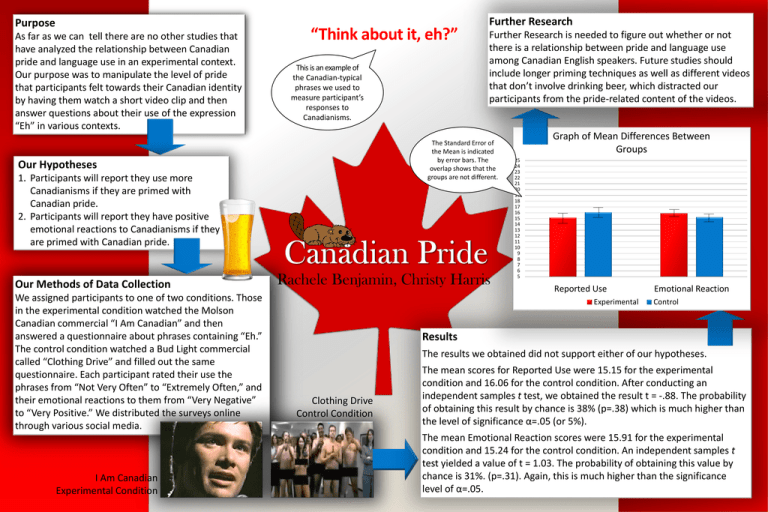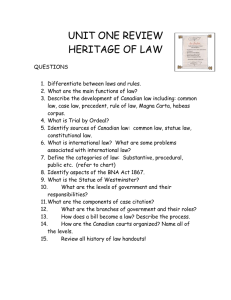“Think about it, eh?” Further Research Purpose
advertisement

Purpose As far as we can tell there are no other studies that have analyzed the relationship between Canadian pride and language use in an experimental context. Our purpose was to manipulate the level of pride that participants felt towards their Canadian identity by having them watch a short video clip and then answer questions about their use of the expression “Eh” in various contexts. “Think about it, eh?” This is an example of the Canadian-typical phrases we used to measure participant’s responses to Canadianisms. 1. Participants will report they use more Canadianisms if they are primed with Canadian pride. 2. Participants will report they have positive emotional reactions to Canadianisms if they are primed with Canadian pride. We assigned participants to one of two conditions. Those in the experimental condition watched the Molson Canadian commercial “I Am Canadian” and then answered a questionnaire about phrases containing “Eh.” The control condition watched a Bud Light commercial called “Clothing Drive” and filled out the same questionnaire. Each participant rated their use the phrases from “Not Very Often” to “Extremely Often,” and their emotional reactions to them from “Very Negative” to “Very Positive.” We distributed the surveys online through various social media. I Am Canadian Experimental Condition Further Research is needed to figure out whether or not there is a relationship between pride and language use among Canadian English speakers. Future studies should include longer priming techniques as well as different videos that don’t involve drinking beer, which distracted our participants from the pride-related content of the videos. The Standard Error of the Mean is indicated by error bars. The overlap shows that the groups are not different. Our Hypotheses Our Methods of Data Collection Further Research Rachele Benjamin, Christy Harris Graph of Mean Differences Between Groups 25 24 23 22 21 20 19 18 17 16 15 14 13 12 11 10 9 8 7 6 5 Reported Use Experimental Emotional Reaction Control Results The results we obtained did not support either of our hypotheses. Clothing Drive Control Condition The mean scores for Reported Use were 15.15 for the experimental condition and 16.06 for the control condition. After conducting an independent samples t test, we obtained the result t = -.88. The probability of obtaining this result by chance is 38% (p=.38) which is much higher than the level of significance α=.05 (or 5%). The mean Emotional Reaction scores were 15.91 for the experimental condition and 15.24 for the control condition. An independent samples t test yielded a value of t = 1.03. The probability of obtaining this value by chance is 31%. (p=.31). Again, this is much higher than the significance level of α=.05.




